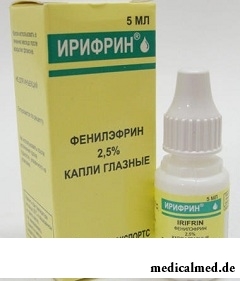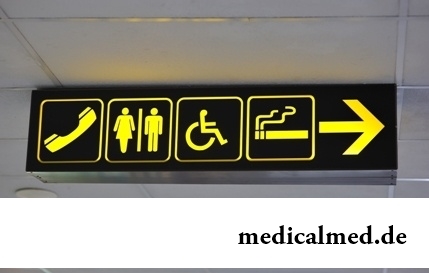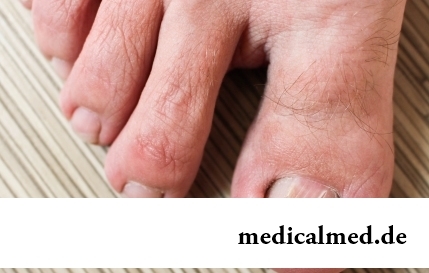





Irifrin
Application instruction:
 Irifrin – drug about the alpha adrenomimeticheskim action used in ophthalmology.
Irifrin – drug about the alpha adrenomimeticheskim action used in ophthalmology.
Form of release and structure
Irifrin produce eye 2,5% and 10% in the form of drops: transparent solution from light yellow color to colourless (on 5 ml in dark glass bottles complete with a dropper or plastic bottles droppers, on 1 bottle dropper or a bottle in a cardboard pack).
Is a part of 1 ml of drops:
- Active agent: Phenylephrinum – 25 or 100 mg (in the form of a hydrochloride);
- Auxiliary components: chloride a benzalkoniya, эдетат dinatrium, sodium hydroxide, sodium metabisulphite, citric acid, a sodium citrate dihydrate, water for injections; in addition for 10% of drops: hydrosodium phosphate dihydrate, anhydrous dihydrosodium phosphate.
Indications to use
- Glaukomo-tsiklitichesky crises (treatment);
- Iridocyclitis (prevention of emergence of back synechias (commissures of an iris) and for reduction of exudation from an iris of the eye);
- Syndrome of "a red eye" (treatment for the purpose of reduction of irritation and a hyperemia of covers of an eye, is applied by 2,5% Irifrin);
- Accommodation spasm;
- Diagnostic mydriasis at survey of an eyeground (oftalmoskopiya) and holding other diagnostic procedures for control of a condition of a back piece of an eye;
- Differential diagnosis of an injection (deep and superficial) eyeglobe;
- The provocative test at patients with a narrow corner of an anterior chamber of an eye and at suspicion of closed-angle glaucoma;
- Laser interventions on an eyeground, vitreoretinalny surgery (for a mydriasis);
- Preoperative preparation for a mydriasis in an ophthalmosurgery (10% Irifrin are applied).
Contraindications
- Glaucoma (uzkougolny or closed-angle);
- Aneurism of arteries (for 10% of drops eye);
- Hepatic porphyria;
- Hyperthyroidism;
- Inborn deficit glyukozo-6-fosfatdegidrogenazy;
- Age up to 12 years (for 10% of drops eye);
- Hypersensitivity to drug components.
Also Irifrin it is contraindicated to the elderly patients having serious violations of cerebral circulation and cardiovascular system, to premature children to apply (to 2,5% of drops eye) and as means for an additional mydriasis during surgeries at disturbance of a slezoproduktion, and also patients with disturbance have an integrity of an eyeglobe.
Irifrin's use by the feeding and pregnant women perhaps only when the expected advantage for health of mother is higher than the existing risk for the child or a fruit (because of insufficiency of clinical data on safety and efficiency of performing therapy at this category of patients).
Route of administration and dosage
When carrying out an oftalmoskopiya in the form of instillations 2,5% of a drop eye are once applied. Usually for creation of a mydriasis there is enough introduction of 1 drop to a conjunctival sac. The maximum mydriasis is reached in 15-30 minutes, within 1-3 hours the mydriasis remains at the sufficient level. In need of maintenance of a mydriasis for an appreciable length of time, in 1 hour carrying out repeated instillation of Irifrin is possible.
At an insufficient mydriasis at adults and children of 12 years, and also at patients with the rigid iris (expressed by pigmentation) it is possible to apply 10% of a drop to a diagnostic mydriasis eye in the same dose.
To remove a spasm of accommodation by the adult and to children of 6 years appoint 2,5% of a drop eye – daily on 1 drop in each eye to night for 4 weeks.
At a resistant spasm of accommodation at adults and children of 12 years use of 10% of drops eye – daily on 1 drop in each eye for the night for 2 weeks is possible.
When holding diagnostic procedures single instillation of 2,5% of drops eye is applied in the following cases:
- The provocative test at patients with a narrow profile of a corner of an anterior chamber and at suspicion of closed-angle glaucoma. Test results are considered positive in cases when the difference between values of intraocular pressure before Irifrin's use and after a mydriasis fluctuates within 3-5 mm hg;
- Differential diagnosis like eyeglobe injection. At eyeglobe vasoconstriction in 5 minutes after an instillation the injection is classified as superficial, at preservation of reddening of eyes it is necessary to inspect carefully the patient on existence of a sclerite or iridocyclitis as it demonstrates expansion of the vessels lying more deeply.
At iridocyclites 2,5% or 10% Irifrin – on 1 drop in a conjunctival sac of a sore eye (eyes) 2-3 times a day apply to decrease in exudation (release of liquid from small blood vessels at an inflammation) in an anterior chamber of an eye and to prevention of education and a rupture of already existing back synechias.
Thanks to vasopressor action of Phenylephrinum at glaukomo-tsiklitichesky crises there is a decrease in intraocular pressure. This action is more expressed at use of 10% of Irifrin. For stopping of glaukomo-tsiklitichesky crises it is necessary to dig in drug 2-3 times a day.
By preparation for carrying out surgical intervention in 30-60 minutes prior to it single instillation of 10% of Irifrin is made for a mydriasis. After the eyeglobe cover will be opened, repeated use of drug is not allowed.
10% of a drop do not apply to an irrigation, subconjunctival introduction and treatment of tampons when performing surgeries.
Side effects
At Irifrin's use development of disturbances from some systems of an organism is possible:
- Cardiovascular system: tachycardia, a heart consciousness, arrhythmia (including ventricular), reflex bradycardia, arterial hypertension, an embolism of a pulmonary artery and occlusion of coronary arteries are possible; seldom (at use of 10% of drops) there are serious violations including a myocardial infarction, intracraneal hemorrhage and a vascular collapse;
- Organ of sight: periorbital hypostasis, conjunctivitis; at the beginning of use dacryagogue, a burning sensation, increase in intraocular pressure, irritation, a sight zatumanennost, feeling of discomfort is possible. Next day after Irifrin's use the reactive miosis can develop. The mydriasis at repeated instillations of drug during this period can be a little less expressed, than on the eve of (is more often at patients of advanced age). In 30-45 minutes after instillation because of considerable reduction of the dilator of a pupil under the influence of active agent (Phenylephrinum) in moisture of an anterior chamber of an eye parts of a pigment from a pigmental leaf of an iris of the eye can be found. The suspension in chamber moisture needs to be differentiated with hit of uniform elements of blood in moisture of an anterior chamber or with development of a front uveitis;
- Dermatological reactions: contact dermatitis.
Special instructions
Irifrin it is necessary to apply with care at elderly patients (because of increase in risk of emergence of a reactive miosis) and at patients with a diabetes mellitus (because of risk of increase in the arterial pressure connected with disturbances of vegetative regulation).
Also drug is appointed with care along with monoamine oxidase inhibitors and for 21 days after the termination of their use.
Exceeding of the recommended doses at use of 2,5% of drops for patients with injuries, diseases of eyes or their appendages, during the postoperative period or at a reduced slezoproduktion (because of anesthesia) can lead to increase in absorption of Phenylephrinum and, therefore, to development of systemic side effects.
Because Irifrin causes a conjunctiva hypoxia, it needs to be applied with care when carrying contact lenses, at patients with a sickemia, and also after operative measures (because of decrease in healing).
Medicinal interaction
At simultaneous use of Irifrin with some medicines there can be undesirable effects:
- Atropine: strengthening of mydriatic effect of Phenylephrinum; development of tachycardia because of strengthening of angiotonic action is also possible;
- Monoamine oxidase inhibitors (at the same time and within 3 weeks after the end of their use): existence of risk of development of uncontrollable rise in arterial pressure;
- Tricyclic antidepressants, propranolol, Reserpinum, гуанетидин, Methyldopum and m-holinoblokatory: potentiation of angiotonic action;
- Beta adrenoblockers (system use): development of acute arterial hypertension (at use of 10% of drops);
- Inhalation anesthesia: potentiation of the oppressing influence on cardiovascular system;
- Sympathomimetics: strengthening of cardiovascular effects of Phenylephrinum.
Terms and storage conditions
To store in protected from light, the place, unavailable to children, at a temperature up to 25 °C, not to freeze.
Period of validity – 2 years.
After opening of a bottle of a drop it is possible to use within 1 month.
Name of drug
Price
Drugstore
Irifrin of a hl drop. 2.5% of 5 ml, Promed Exports
568 rub.
 Network of the Moscow drugstores of IFC
Network of the Moscow drugstores of IFCIrifrin BK of a hl drop. 2.5% 0,4ml tube dropper, No. 15, Promed Exports
686 rub.
 Network of the Moscow drugstores of IFC
Network of the Moscow drugstores of IFCHuman bones are stronger than concrete four times.

It would seem, to buy drugs in Moscow does not make a problem – a drugstore, and not one, is available for each resident of the capital in step a toast...
Section: Articles about health
The state of health of the person depends on many factors. One of the most important is the constant, but not exhausting a physical activity. In the presence of various illnesses specialists often advise patients to do swimming which by right borrows ведущ...
Section: Articles about health
Beauty shop – the place which is associated only with positive emotions: joy, pleasure, relaxation. However visit of salon where work with biological material of clients, not always harmlessly is conducted. Today more than 100 pathogenic microorganisms who can catch in beauty shop including deadly to health are known....
Section: Articles about health
The fatigue, sleep debt, disturbances of food, bad mood, vagaries of the weather – all these circumstances badly are reflected in our vn...
Section: Articles about health
The kid who was recently born is surrounded with love of adult family members and their cares without which the baby cannot exist. Some parents consider that gentle attachment and caress are quite enough that the child correctly developed and was happy...
Section: Articles about health
The drugs stopping or oppressing life activity of pathogenic microorganisms are widely applied in clinical practice from 40th years of the last century. Originally antibiotics were called only substances natural (animal, vegetable or microbic) origins, but over time this concept extended, and it includes also semi-synthetic and completely artificial antibacterial drugs....
Section: Articles about health
The medicine promptly develops, and the fact that else quite recently it seemed by miracle can now. We are not surprised any more to the fact that sport...
Section: Articles about health
The saying "the rich do not know how the other half lives" is known to all. In a broad sense it is that we can not always understand the person whose features of a state are unknown to us. If with physiological characters of diseases the situation is more or less clearly (having noticed and...
Section: Articles about health
Epilepsy is one of widespread neurologic diseases. Parents, whose children suffer from this illness, should face rumors and delusions, many of which remained since the Middle Ages....
Section: Articles about health
Each person knows that fervescence is an illness sign. However about existence of diseases can to suite...
Section: Articles about health
The next flu epidemic leads to the next panic, from year to year we give in on these manipulations: professionally alarming voice of the announcer in news, reports with calculation of the died patients, an interview with people in white dressing gowns and advertizing of anti-influenza means ра...
Section: Articles about health
The words "disease" and "patient" not without reason come from one root – "pain". As a rule, symptoms of illnesses thoroughly spoil to patients life. However from this rule there are exceptions. Some diseases are shown by signs which can cause even positive emotions. It is a pity only that the majority of such illnesses are heavy and incurable....
Section: Articles about health
The body of the person almost for 60% consists of water. It is so important for normal functioning of an organism that loss of all is ponut...
Section: Articles about health
The word "onikhokriptoz" is unfamiliar to most of people, meanwhile quite so physicians call very widespread problem: the growing of edge of a nail into surrounding fabrics causing inflammatory process. Usually the illness affects thumbs of legs, and is followed покр...
Section: Articles about health
The state of health of the person in many respects depends on chemical composition of biological liquids of an organism. Specialists consider that PH value of these solutions has to be in range of 7,35-7, 45. The deviation in the smaller party (so-called "acidulation") is fraught with development of many heavy illnesses, failures in work of immune system, decrease in working capacity and deterioration of life. To avoid serious fluctuations of acidity of internal liquids it is necessary to adhere разумног...
Section: Articles about health
Very often as a source of the infection which caused a disease serves our house - the place which a priori has to be safe. However...
Section: Articles about health
It seems, quite recently you brought the baby from maternity hospital, but time flew by, and here it is already going to join the first in life children's collective. How to prepare the child for visit of a garden? What needs to teach him to facilitate process адап...
Section: Articles about health
The Genetically Modified Organisms (GMO) are plants or animals (as a rule, agricultural) to whose genotype purposeful changes were made. Opposition of supporters and opponents of inclusion of such organisms in foodstuff always was very acute. Not only scientists and dietitians, but also a large number of the people who are not specialists in this question are involved in active disputes today....
Section: Articles about health
Within several decades of our compatriots convinced that the use of butter nasty affects on...
Section: Articles about health
(Xerostomia) many people consider feeling of a xerostomia small and easily removable inconvenience. This delusion: the symptom can demonstrate existence of serious diseases. It is worth to remember also that saliva performs important functions...
Section: Articles about health
A lot of things depend on a condition of a backbone in a human body, a backbone - not only a support for a body, it also a receptacle for a spinal cord, that is why malfunctions with a backbone are so dangerous. To treat rachis diseases very difficult and long, it is much simpler and more correct not to bring to a disease. Conforming to the rules provided in this article it is possible to avoid the majority of the problems connected with a backbone including those which are considered to be age, but a cat...
Section: Articles about health
The stroke is one of the most widespread diseases of the person, annually in the world about 6 million cases эт are registered...
Section: Articles about health
Season of activity of viral infections in the heat. Everyone can get sick, but probability of this unpleasant event it is possible and it is necessary to minimize. There is a number of rules, following to which will help or to avoid absolutely infection with flu or a SARS, or to have an illness...
Section: Articles about health
The naturopathy sometimes moves as the new direction of medicine, something like fashionable hobby, and there is nothing farther from the truth. This most ancient direction, the word "naturopathy" is translated as "treatment by the nature", and, no doubt, treatment by natural gifts was the first and only, available to the person in ancient times. Despite modern achievements of medicine, the naturopathy remains urgent and today, anyway the person - a part of the nature, and природн...
Section: Articles about health
Life of the modern child is extremely active and difficult. Information strain which is experienced by the school student and did not dream the pupil...
Section: Articles about health
Cold – a state known to everyone which is followed by cold, cough, high temperature, a pharyngalgia. Often the first that we begin to do in hope again to become healthy – to accept medicines which are not always harmless, then...
Section: Articles about health
Cellulitis - very widespread cosmetic shortcoming which arises approximately at 80% of women sooner or later. Emergence it is connected with change of structure of a hypodermic fatty layer. At the same time on the surface of skin at first there are roughnesses (cambers and cavities), and then small consolidations, the so-called effect of an orange-peel is shown. Changes in a condition of hypodermic cellulose are a consequence of a hormonal imbalance in an organism....
Section: Articles about health

